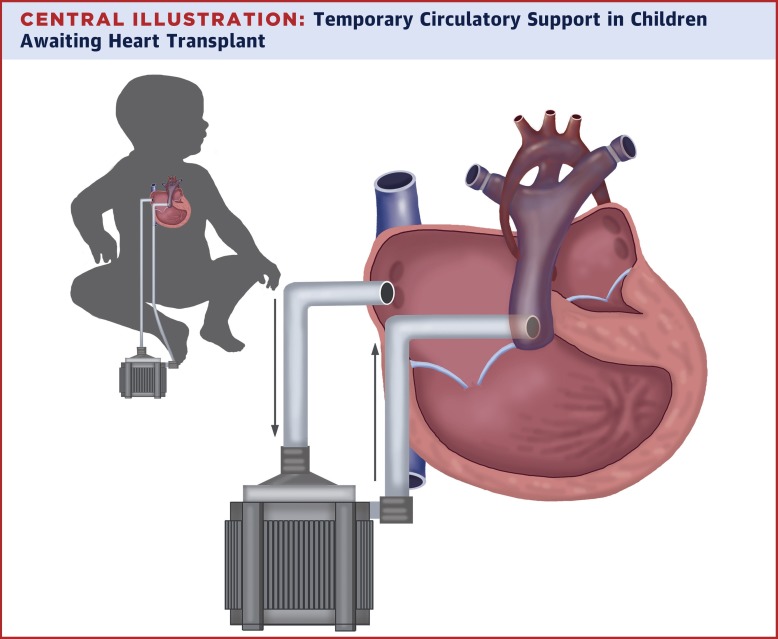当前位置:
X-MOL 学术
›
J. Am. Coll. Cardiol.
›
论文详情
Our official English website, www.x-mol.net, welcomes your feedback! (Note: you will need to create a separate account there.)
Temporary Circulatory Support in U.S. Children Awaiting Heart Transplantation
Journal of the American College of Cardiology ( IF 24.0 ) Pub Date : 2017-10-01 , DOI: 10.1016/j.jacc.2017.08.072 Vamsi V. Yarlagadda , Katsuhide Maeda , Yulin Zhang , Sharon Chen , John C. Dykes , Mary Alice Gowen , Paul Shuttleworth , Jenna M. Murray , Andrew Y. Shin , Olaf Reinhartz , David N. Rosenthal , Doff B. McElhinney , Christopher S. Almond
Journal of the American College of Cardiology ( IF 24.0 ) Pub Date : 2017-10-01 , DOI: 10.1016/j.jacc.2017.08.072 Vamsi V. Yarlagadda , Katsuhide Maeda , Yulin Zhang , Sharon Chen , John C. Dykes , Mary Alice Gowen , Paul Shuttleworth , Jenna M. Murray , Andrew Y. Shin , Olaf Reinhartz , David N. Rosenthal , Doff B. McElhinney , Christopher S. Almond

|
BACKGROUND
Extracorporeal membrane oxygenation (ECMO) has long served as the standard of care for short-term mechanical circulatory support in pediatrics. It is unknown whether newer-generation temporary circulatory support (TCS) devices afford children a meaningful survival advantage over ECMO. OBJECTIVES
This study sought to determine whether bridge-to-heart transplant survival with a TCS device is superior to ECMO after adjusting for patient differences. METHODS
All children ≤21 years of age listed for heart transplant from 2011 to 2015 who received a TCS device or ECMO as a bridge to transplant were identified using Organ Procurement and Transplantation Network data. Children supported with a TCS device were compared with a propensity score (PS)-matched cohort of children supported with ECMO as a bridge to transplant. The primary endpoint was Kaplan-Meier survival to transplant. RESULTS
The number of TCS devices implanted in children increased from ≤3 per year before 2011 to 50 in 2015. Overall, 93 patients implanted with TCS devices were included for analysis (59% left ventricular assist devices, 23% right ventricular assist devices, 18% biventricular assist devices). The most commonly used device was the CentriMag-PediMag system (65%), followed by TandemHeart (18%), Rotaflow (6%), and Impella (5%). Among 164 PS-matched patients, support duration was longer for the TCS cohort (median 19 days vs. 6 days; p < 0.001), and was longest for the CentriMag-PediMag (24 days vs. 6 days; p < 0.001) with 27% supported for >60 days. Compared with the ECMO cohort, the PS-matched TCS cohort had longer survival to transplant (hazard ratio: 0.49; 95% confidence interval: 0.30 to 0.79) and longer overall survival (hazard ratio: 0.61; 95% confidence interval: 0.39 to 0.96), with 90-day mortality before transplant that was modestly reduced (from 45% with ECMO to 39% with TCS). CONCLUSIONS
The use of TCS devices in children as a bridge to transplant has risen rapidly in recent years, led by the growth of magnetically levitated centrifugal flow pumps. Compared with conventional ECMO, TCS durations are longer, and more importantly, patient survival is superior.
中文翻译:

等待心脏移植的美国儿童的临时循环支持
背景体外膜肺氧合(ECMO)长期以来一直是儿科短期机械循环支持的护理标准。与 ECMO 相比,新一代临时循环支持 (TCS) 设备是否为儿童提供了有意义的生存优势尚不清楚。目的 本研究旨在确定在调整患者差异后,使用 TCS 装置进行心脏桥移植的存活率是否优于 ECMO。方法 使用器官采购和移植网络数据识别 2011 年至 2015 年所有接受 TCS 设备或 ECMO 作为移植桥梁的 21 岁以下心脏移植儿童。将使用 TCS 设备支持的儿童与使用 ECMO 作为移植桥梁的倾向评分 (PS) 匹配的儿童队列进行比较。主要终点是移植的 Kaplan-Meier 存活率。结果 儿童植入 TCS 装置的数量从 2011 年之前的每年≤3 件增加到 2015 年的 50 件。总体而言,共有 93 名植入 TCS 装置的患者被纳入分析(59% 左心室辅助装置,23% 右心室辅助装置,18 % 双心室辅助装置)。最常用的设备是 CentriMag-PediMag 系统 (65%),其次是 TandemHeart (18%)、Rotaflow (6%) 和 Impella (5%)。在 164 名 PS 匹配的患者中,TCS 队列的支持持续时间更长(中位数 19 天 vs. 6 天;p < 0.001),而 CentriMag-PediMag 最长(24 天 vs. 6 天;p < 0.001)与27% 支持超过 60 天。与 ECMO 队列相比,PS 匹配的 TCS 队列具有更长的移植存活率(风险比:0.49;95% 置信区间:0.30 至 0.79)和更长的总生存期(风险比:0.61;95% 置信区间:0.39 至 0.96),移植前 90 天死亡率适度降低(从 ECMO 的 45% 降至 39%) TCS)。结论 近年来,由于磁悬浮离心泵的发展,在儿童中使用 TCS 装置作为移植的桥梁迅速增加。与传统 ECMO 相比,TCS 持续时间更长,更重要的是患者生存率更高。由磁悬浮离心泵的发展带动。与传统 ECMO 相比,TCS 持续时间更长,更重要的是患者生存率更高。由磁悬浮离心泵的发展带动。与传统 ECMO 相比,TCS 持续时间更长,更重要的是患者生存率更高。
更新日期:2017-10-01
中文翻译:

等待心脏移植的美国儿童的临时循环支持
背景体外膜肺氧合(ECMO)长期以来一直是儿科短期机械循环支持的护理标准。与 ECMO 相比,新一代临时循环支持 (TCS) 设备是否为儿童提供了有意义的生存优势尚不清楚。目的 本研究旨在确定在调整患者差异后,使用 TCS 装置进行心脏桥移植的存活率是否优于 ECMO。方法 使用器官采购和移植网络数据识别 2011 年至 2015 年所有接受 TCS 设备或 ECMO 作为移植桥梁的 21 岁以下心脏移植儿童。将使用 TCS 设备支持的儿童与使用 ECMO 作为移植桥梁的倾向评分 (PS) 匹配的儿童队列进行比较。主要终点是移植的 Kaplan-Meier 存活率。结果 儿童植入 TCS 装置的数量从 2011 年之前的每年≤3 件增加到 2015 年的 50 件。总体而言,共有 93 名植入 TCS 装置的患者被纳入分析(59% 左心室辅助装置,23% 右心室辅助装置,18 % 双心室辅助装置)。最常用的设备是 CentriMag-PediMag 系统 (65%),其次是 TandemHeart (18%)、Rotaflow (6%) 和 Impella (5%)。在 164 名 PS 匹配的患者中,TCS 队列的支持持续时间更长(中位数 19 天 vs. 6 天;p < 0.001),而 CentriMag-PediMag 最长(24 天 vs. 6 天;p < 0.001)与27% 支持超过 60 天。与 ECMO 队列相比,PS 匹配的 TCS 队列具有更长的移植存活率(风险比:0.49;95% 置信区间:0.30 至 0.79)和更长的总生存期(风险比:0.61;95% 置信区间:0.39 至 0.96),移植前 90 天死亡率适度降低(从 ECMO 的 45% 降至 39%) TCS)。结论 近年来,由于磁悬浮离心泵的发展,在儿童中使用 TCS 装置作为移植的桥梁迅速增加。与传统 ECMO 相比,TCS 持续时间更长,更重要的是患者生存率更高。由磁悬浮离心泵的发展带动。与传统 ECMO 相比,TCS 持续时间更长,更重要的是患者生存率更高。由磁悬浮离心泵的发展带动。与传统 ECMO 相比,TCS 持续时间更长,更重要的是患者生存率更高。



























 京公网安备 11010802027423号
京公网安备 11010802027423号